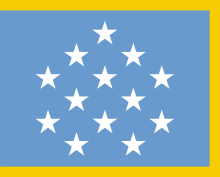Flags and guidons of the United States Army
Jump to navigation
Jump to search
Main categories: Flags of the United States Army and Guidons of the United States Army
- United States Army flags traditionally have been used for purposes of identification and the fostering of esprit de corps. The present policies stem from ideas and practices dating back to the Revolutionary War. In turn, those were influenced by the military traditions of Western Europe to a great extent. The English, French, Dutch, Spanish, and others brought to North America their flags, military uniforms and other official symbolism. Leaders of the colonists were familiar with military traditions and those of England and France, particularly.


- With the Declaration of Independence and the formation of troops, came the need for items to identify the soldiers and military units. On February 20, 1776, Washington's headquarters issued as order on flags quoted, in part, below:
- "As it is necessary that every Regiment should be furnished Colours, and that those Colours should…bear some kind of similitude to the Uniform of the regiment to which they belong, the Colonels… may fix upon such as are proper, the standard (or Regimental Colours) and Colours for each Grand Division, …The Number of the Regiment is to be mark’d on the Colours, and such a Motto, as the Colonel may choose, in fixing upon which, the General advises a Consultation amongst them. The Colonels are to delay no time, in getting this matter fix’d, that the Qr. Mr. Genl. May provide the Colours as soon as possible;…"


- This order emphasized the significance of organizational colors to the Army by directing expeditious design and procurement; delegated responsibility for design and procurement and prescribed design pattern elements.
- As late as 1779, the designs of regimental and national colors to be carried by Army organizations were the subject of correspondence between Washington and Richard Peters of the Board of War. From that correspondence it is evident that the Americans intended to follow the British practice of using two different designs for the National flag: one for the Naval or Marine flat and the other for the battle or Army flag. By 1780, the stars and stripes design flag adopted by the United States in 1777 was generally known as the marine (maritime) flag used extensively at sea; but no Army National flag had been adopted prior to 1780.


- The first Army National color was of blue incorporating the design of an eagle displayed (somewhat similar to that in the coat of arms adopted for the United States) and the name of the regiment. That National color of the Army was carried until 1841 when it became the regimental color. From that blue flag evolved the eagle on regimental and battalion flags and, finally, on Major Army Command flags.
- The precedents for the current United States system of designing flags for units was established during the Revolution. From the policies established at that time evolved the basis of future systems of identification of units through the flags displayed. There were many additions and modifications in flags throughout the years. The numerical strength and organization of the Army changed; different weapons were adopted; methods of warfare were revised; materials and methods of manufacture of fabrics were improved.


- Continuous recognition of the significance of flags to the morale of members of the Army resulted in the development of a well-defined system of flags for organizations at all echelons. In general, flags incorporate design elements which are identical to or relate to the insignia worn by the members of the organization.


This image shows a flag, a coat of arms, a seal or some other official insignia produced by the United States Army Institute of Heraldry. It is in the public domain but its use is restricted by Title 18, United States Code, Section 704 [1] and the Code of Federal Regulations (32 CFR, Part 507) [2], [3]. Permission to use these images in the USA for most commercial purposes must be obtained from The Institute of Heraldry prior to their use.
|
 |
- US Army Institute Of Heraldry